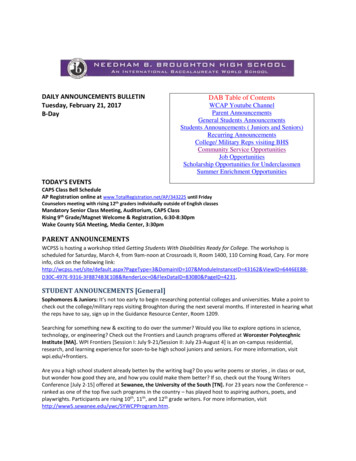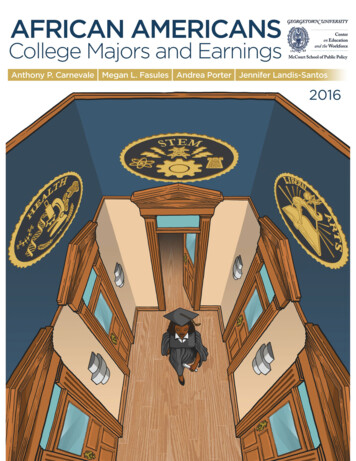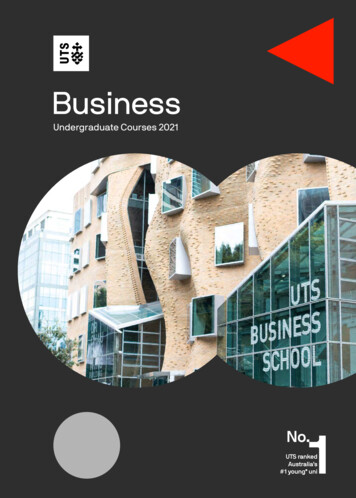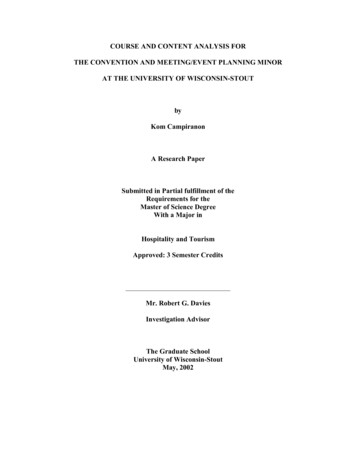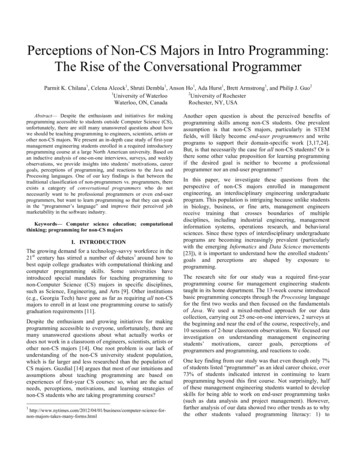
Transcription
Perceptions of Non-CS Majors in Intro Programming:The Rise of the Conversational ProgrammerParmit K. Chilana1, Celena Alcock1, Shruti Dembla1, Anson Ho1, Ada Hurst1, Brett Armstrong1, and Philip J. Guo212University of WaterlooUniversity of RochesterWaterloo, ON, CanadaRochester, NY, USAAbstract— Despite the enthusiasm and initiatives for makingprogramming accessible to students outside Computer Science (CS),unfortunately, there are still many unanswered questions about howwe should be teaching programming to engineers, scientists, artists orother non-CS majors. We present an in-depth case study of first-yearmanagement engineering students enrolled in a required introductoryprogramming course at a large North American university. Based onan inductive analysis of one-on-one interviews, surveys, and weeklyobservations, we provide insights into students’ motivations, careergoals, perceptions of programming, and reactions to the Java andProcessing languages. One of our key findings is that between thetraditional classification of non-programmers vs. programmers, thereexists a category of conversational programmers who do notnecessarily want to be professional programmers or even end-userprogrammers, but want to learn programming so that they can speakin the “programmer’s language” and improve their perceived jobmarketability in the software industry.Keywords— Computer science education; computationalthinking; programming for non-CS majorsI. INTRODUCTIONThe growing demand for a technology-savvy workforce in the21st century has stirred a number of debates1 around how tobest equip college graduates with computational thinking andcomputer programming skills. Some universities haveintroduced special mandates for teaching programming tonon-Computer Science (CS) majors in specific disciplines,such as Science, Engineering, and Arts [9]. Other institutions(e.g., Georgia Tech) have gone as far as requiring all non-CSmajors to enroll in at least one programming course to satisfygraduation requirements [11].Despite the enthusiasm and growing initiatives for makingprogramming accessible to everyone, unfortunately, there aremany unanswered questions about what actually works ordoes not work in a classroom of engineers, scientists, artists orother non-CS majors [14]. One root problem is our lack ofunderstanding of the non-CS university student population,which is far larger and less researched than the population ofCS majors. Guzdial [14] argues that most of our intuitions andassumptions about teaching programming are based onexperiences of first-year CS courses: so, what are the actualneeds, perceptions, motivations, and learning strategies ofnon-CS students who are taking programming htmlAnother open question is about the perceived benefits ofprogramming skills among non-CS students. One prevalentassumption is that non-CS majors, particularly in STEMfields, will likely become end-user programmers and writeprograms to support their domain-specific work [3,17,24].But, is that necessarily the case for all non-CS students? Or isthere some other value proposition for learning programmingif the desired goal is neither to become a professionalprogrammer nor an end-user programmer?In this paper, we investigate these questions from theperspective of non-CS majors enrolled in managementengineering, an interdisciplinary engineering undergraduateprogram. This population is intriguing because unlike studentsin biology, business, or fine arts, management engineersreceive training that crosses boundaries of multipledisciplines, including industrial engineering, managementinformation systems, operations research, and behavioralsciences. Since these types of interdisciplinary undergraduateprograms are becoming increasingly prevalent (particularlywith the emerging Informatics and Data Science movements[23]), it is important to understand how the enrolled students’goals and perceptions are shaped by exposure toprogramming.The research site for our study was a required first-yearprogramming course for management engineering studentstaught in its home department. The 13-week course introducedbasic programming concepts through the Processing languagefor the first two weeks and then focused on the fundamentalsof Java. We used a mixed-method approach for our datacollection, carrying out 25 one-on-one interviews, 2 surveys atthe beginning and near the end of the course, respectively, and10 sessions of 2-hour classroom observations. We focused ourinvestigation on understanding management engineeringstudents’ motivations, career goals, perceptions ofprogrammers and programming, and reactions to code.One key finding from our study was that even though only 7%of students listed “programmer” as an ideal career choice, over73% of students indicated interest in continuing to learnprogramming beyond this first course. Not surprisingly, halfof these management engineering students wanted to developskills for being able to work on end-user programming tasks(such as data analysis and project management). However,further analysis of our data showed two other trends as to whythe other students valued programming literacy: 1) to
understand the work of professional programmers andestablish common ground in communication and, 2) toincrease the perceived marketability of their skills for futureinternships and jobs. We characterize this subgroup asconversational programmers—students who want to beliterate in programming not for the sake of becomingprofessional or end-user programmers, but for the pragmaticreason of being able to converse in the “programmer’slanguage” and improving their perceived marketability in thesoftware industry. Our initial results suggest that theseconversational programmers perceive industry-standardlanguages (e.g., Java) to be more beneficial than visual ordomain-specific teaching languages (e.g., Processing) thatsimplify programming syntax.Our main contribution in this paper is in providing empiricalevidence that shows that among the traditional classificationof non-programmers vs. end-user programmers vs.professional programmers, there exists a category ofconversational programmers who fall between the spectrum ofnon-programmers and end-user programmers and who want tolearn to “speak the programmer’s language”. Given thediversity of non-CS students coming into introductoryprogramming classrooms, there is a greater need to betterunderstand these students’ perceptions and enthusiasm forprogramming. In our discussion, we tackle the question ofhow we should be thinking about training conversationalprogrammers and non-CS majors in general and how we canstrike a balance between teaching programming forintellectual enrichment vs. job marketability.II. RELATED WORKDespite decades of research in computing education, theexisting literature mostly focuses on the experiences ofteaching programming to first-year CS students—there arefew direct investigations of the experiences of non-CS majors.Still, many recommendations have been made for simplifyingintroductory programming courses that are relevant for nonCS majors.Lightweight introductory CS courses: Many languages havebeen used throughout the years for teaching introductory CScourses (Java, C, and C top the list of the most widely usedprogramming languages in the last two decades [21,25]).There have been many debates and concerns around how tobalance the need to teach such mainstream languages withoutadding extra complexity to introducing CS concepts,especially for novices [5,15,20]. One approach advocated forteaching non-CS students is to take a subset of the contentfrom a course for CS majors [9,10,18,26] and create a“lightweight” introduction. This approach simplifies the introCS content by focusing on programming fundamentals, whilestill introducing a widely-used language. Although there issome evidence that tailoring traditional intro CS courses tonon-CS majors can be successful, we do not know if thisapplies to all categories of non-CS majors or if some non-CSmajors are more likely to benefit. The programming coursethat is the subject of our study used the approach of creating a“lightweight” introduction (using Processing), while still usingJava as the main programming language and curriculumadapted from an introductory CS course.Visual languages that simplify programming: Instead ofteaching mainstream programming languages, someresearchers argue for the use of visual programming tosimplify the teaching of complex concepts. Visualprogramming languages allow users to visually demonstrate orsketch their program flow, rather than using commands,pointers, and abstract symbols [1, 2]. Visual programmingenvironments based on storytelling metaphors, such as Scratch[22] or Alice [16], have been shown to be particularlysuccessful at introducing basic programming concepts byletting students create multimedia animations. Similarrecommendations have been embodied in efforts such asRAPTOR [4] that uses flowcharts to demonstrate complexconcepts and App Inventor [28] that focuses on visual mobileapplication development.A recent trend has been to use the Processing2 language inintro programming courses. Processing is an open-sourcelanguage derived from Java that is designed to allowprogrammers to easily add graphics, animation, media, anduser interaction to their programs. This language has beenparticularly appealing for teaching first-year students [19]because of the simplicity in setting up the developmentenvironment and creating interactive programs. Processingoffers many built-in methods that allow students to tackle avariety of problems without getting too caught up inprogramming logic and syntax early on. In our study, we shedlight on how the participants reacted to Processing, thetransition to Java later in the course, and some of the tensionsaround ease-of-learning vs. future marketability.Teaching programming in context: Another teachingapproach for non-CS majors has been to create completelynew courses that focus on programming in the context of othercomputational tasks For example, in the media computationcourse at Georgia Tech [3,11,13], Arts students get anintroduction to programming by working with popularmedia—manipulating filters on images, editing sounds inaudio files, writing scripts to extract content from the Web,creating animations, and so forth. In the software carpentryinitiative [27], scientists are taught basic computing skills anduse of command-line scripting tools to make them moreefficient in scientific computation. There have also beenefforts to teach domain-specific programming to experts suchas professional designers who often learn programming skills“on the job” in the context of their daily design work [7]. Theunderlying assumption of teaching programming “in context”is that students work on end-user programming tasks in theirrespective domains. However, as we found in our study, eventhough most of the students wanted to take other programmingcourses, a portion of the management engineering students2http://www.processing.org
were interested only in programming literacy and not inbecoming end-user programmers.In summary, prior work has made a number ofrecommendations for simplifying intro CS curricula andprogramming languages to accommodate the needs of noviceprogrammers and non-CS majors, but the recommendationshave not necessarily taken into account the diversity withinthe non-CS student population. Furthermore, with the rise ofinterdisciplinary programs, we can no longer assume that whatworks for a particular group of scientists, artists, or engineerswill necessarily be applicable to students who are enrolled ininterdisciplinary programs. Our case study adds detailedinsights into the perceptions, reactions, and goals ofinterdisciplinary management engineers and how they differfrom previous characterizations of non-CS majors in introprogramming.III. RESEARCH SITE AND METHODA. Research SiteWe conducted this study in an Introduction to ComputerProgramming course offered as part of the managementengineering undergraduate program at a large North Americanuniversity. Management engineering is an emerging disciplinethat concerns the engineering (i.e., designing, planning oroperating) of management systems. The program can beviewed as a modern form of traditional industrial engineering,with the new take reflecting (in part) the all-encompassing useof information systems in contemporary organizations.The management engineering curriculum incorporates topicspertaining to operations management, logistics and supplychain management, inventory control, economics, accounting,organizational studies, and design of information systems [8].All first-year students in the management engineeringprogram are required to take the introductory programmingcourse taught in the home department. All students in theprogram are also required to participate in the cooperativeeducation internship program (co-op) for at least five termsduring their study. Students can earn this experience in avariety of industries, with a majority of managementengineering students typically working in the manufacturing,high-tech, retail, and financial industries.The course that was the subject of this study introducedprogramming fundamentals in the Processing language for thefirst 2 weeks and transitioned to Java for the remaining 11weeks. The course topics included basic components ofalgorithms, primitive operations, variables, sequencingoperations, conditionals and branching, subroutines, problemdecomposition, abstraction, file-based input and output, use ofa modern development environment, pointers/references, andbasic data structures, such as arrays.B. Study MethodsWe collected data for this study using three different methods:Surveys: Two of the authors distributed two surveyquestionnaires to students enrolled in the course: the firstsurvey was distributed at the beginning of the course (phase 1)and the second near the end of the course (phase 2). Thesurvey was voluntary and did not affect student grades nor didthe instructor have any knowledge of who participated. Thesurveys tried to capture the students’ perceptions of the courseand programming, and their overall career goals. At the end ofthe surveys, students could opt-in to participate in a briefinterview in two different intervals.The survey in phase 1 consisted of questions about priorprogramming experience and reactions to the introduction toProcessing. The survey in Phase 2 focused on Java and thetransition from Processing to Java. It included questions abouthow confident students were using the Java programminglanguage and their reactions to syntax. The surveys also hadquestions about how useful they thought it was to learn moreprogramming languages, if they would consider taking moreprogramming courses, what they would do with programming,their ideal future jobs and career goals related to their major.We received 51 responses to the survey in Phase 1 (responserate of 69%) and 56 responses to the survey in Phase 2(response rate of 75%). We attribute the high response rate tothe surveys being short and distributed on paper during two ofthe tutorial sessions where students often had downtimebetween in-class exercises.One-on-one interviews: Based on the survey responses, twoof the authors recruited 12 interviewees for Phase 1 of thestudy, and 13 interviewees for Phase 2 (both phases hadseparate sets of interviewees). The interviews lasted around 30minutes on average and were semi-structured in format.Both rounds of interviews focused on participants’ rogramming before and after taking the course, theirreactions to learning Processing vs. Java, what the studentswanted to do for their co-op internships in industry, what theywant to do after graduation, and their perceptions around thevalue of learning more programming.Weekly observations: Four of the authors carried out weeklyobservations during a 2-hour tutorial session for the course.These observations were unstructured: the authors tookdetailed de-identified field notes in their notebook aboutstudents’ participation in the tutorial activities, what questionsthey were asking, where they were having confusions ordifficulties, and when they were asking for help.C. Analysis and Presentation of ResultsWe audiotaped and transcribed all of the interviews andobservation notes. All transcripts were organized, coded, andanalyzed using the NVivo data analysis software. We used abottom-up inductive analysis approach to explore differentfacets of the students’ narratives and identified recurringthemes.Since our interviews, surveys, and observations produced alarge amount of data, we present our results in terms of themajor themes that emerged.
IV. WHO ARE MANAGEMENT ENGINEERS?We first present the overall demographics of our studentpopulation, since it differs not only from a typical CS majorpopulation that has been well studied, but also fromtraditional non-CS students due to the interdisciplinarytraining that management engineers receive. Furthermore,since these students were expected to start their first co-opwork term at the end of their first year, we found that most ofthem were already aware of how they would need to markettheir skills for competitive co-op positions (which is typicallynot the case for undergraduates in other programs without coop).In our interviews, we first probed into why students enrolledinto the management engineering program. Many of themsaid they found the interdisciplinary nature of the program tobe appealing. For example, one participant (P12) explained:It [the program] lets me experiment with a bunch ofdifferent fields I never knew what kind of specificengineering field I wanted to narrow down to whiledoing management engineering, it's like I'm learning abit of everything from every other field and at the end Ihave to work with multi disciplinary teams (P12)In our survey, respondents listed a number of different careerpaths as their ideal choice. We classified the free-formresponses into 9 higher-level categories (top 6 categories thatreceived at least 5% of responses are shown in Figure 1). Mostmanagement engineering students were enthusiastic abouttaking on jobs such as a project manager, becoming a businessexecutive, such as a CEO, or owning a business. Only 7%listed programmer as an ideal career choice. (Note that 29% ofrespondents did not answer this survey question or wrote thatthey were not sure). These expectations bear a very limitedresemblance to actual post-graduation employment. Inparticular, over 70% of this program’s graduates work asmanagement consultants or business analysts3. These roles canbe in a variety of contexts including high-tech and supplychain. We do not know how much end-user programming isincluded in these positions, but we do know that some of thesejobs have involved end-user programming. About 10% of thegraduates work in project/program/product management roles.Only a small minority ( 7%) become full-time programmers,and an even smaller minority (3%) become entrepreneurs. Theremaining graduates fulfill traditional industrial engineeringpositions or go on to graduate studies.According to our survey data, 72% of the students had noformal exposure to programming before taking this course and91% were taking a formal course in Java for the first time.(12% of students mentioned getting exposure to languagessuch as C#, Visual Basic, and Python in high school). Ourinterviews revealed that the remaining participants Figure 1: Classification of survey responses into the top 6categories of “ideal jobs” listed by our survey respondentsexposure to programming by studying online tutorials oversummer or winter breaks.Throughout the study, we found that the students’ disciplinarytraining and the co-op program both heavily influenced theirperceptions, self-efficacy, and value judgments related tolearning Processing, Java, and programming in general.V. PERCEPTIONS OF PROGRAMMERSAND PROGRAMMINGOne goal of our study was to understand the perceptions thatstudents had about programmers and programming prior totaking this first-year class. We saw two themes in theresponses: avoiding programming out of fear of the perceivedlearning challenges and simply not being aware of whatprograming actually entailed.For example, one of our interviewees who chose not to take aprogramming course in high school explained his rationale:I wanted to take [programming] in grade 11 [and]grade 12 but I feared that I wasn't capable to think likea computer and I heard that the assignments that theygave were challenging and people kind of just struggledwith it I didn't want to struggle (P11)Another theme we observed in the responses wasmisconceptions and generalizations about what programmersactually do at work:When you think of programming you think of someonelike sitting in a dark room typing on a keyboard all thetime (P06)Many students explained that social media and howprogrammers are portrayed in popular culture contributed totheir perceptions of programming:I just thought programming was mainly used in thehacking field, for example because you know watchingmovies and stuff, right, you see oh they're shutting downstreet lights and stuff (P13)However, within the first few weeks of the course, studentsstarted discovering that programming involved a lot of
problem solving and there was more to it than just "typing in adark room:”You don't have to be amazingly smart to do it but likeyou do have to have the skill of breaking down problemswhich is something I've learned now but before Ithought it was only a subject that a certain few could begood at (P25)Students felt that understanding what programming is and howit actually works helped them debunk some of their earliermisconceptions about the utility of programming: basically everything runs on programming, you've[got] your account, files, everything stored, evenlearning basically the world is connected oncomputers now, and programming runs all our sociallives, academic lives and professional lives. It runseverything. What would we do without programming?(P12)Even though our participants were accustomed to having aheavy engineering workload and challenging math and sciencecourses, they found programming to be a lot different fromtheir other courses:It’s a different type of problem solving I guess. Like inengineering a lot of times you might be battling withrestraints and not having enough resources but this iskind of like analytical thinking about how you canapproach stuff differently (P04)Some students mentioned that after taking the course theyrealized that they would benefit from programming in theireveryday life. They realized that programming was a skill theycould carry with them everywhere:Just the problem solving techniques that you learn Ithink are stuff that you apply even in like day-to-dayproblem solving even if you don't realize it like you'renot writing code when you have an issue on a day-today basis but the problem solving techniques and thesteps that you go through still apply in real life (P19)A. Why Learn Programming If You’re Not Planning onBecoming a Programmer?One salient finding from our surveys was that despite theperceptions that students initially had and some of thefrustrations that they described in learning programming forthe first time, over 73% of the respondents wanted to takeanother programming course after this intro course. When weasked respondents to list the kinds of things they can imagineusing programming for in the future (either for work orhobby), 48% of respondents listed future work-related tasksinvolving end-user programming, such as data analysis,process automation, solving calculations, and making mobileapps, among others. (Interestingly, none of the responsesindicated anything related to pursuing a hobby.)In our interviews, we probed into understanding why studentsvalued programming and wanted to take more programmingcourses (if it was not for the reason of pursuing end-userprogramming). The most common reason was that early on inthe program, students had formed a perception thatprogramming was an “important skill to have on yourresume”, and “a necessary evil” (based on what they hadheard about the co-op program from other students). it became apparent that you had to know some type ofprogramming language.it was like a staple of yourintelligence knowing that if you knew how to program like you need something to attract an employer and itseemed like everybody was mentioning programming sothat was something that you kind of had to look intoeven if you didn't really want to I'm enjoying it[programming] even though like again it's tedious butthe reason I first looked into it was because it seemedlike you needed it to, to even apply to any [co-op] jobbasically (P25)Increasing the potential for securing job opportunities was oneof the most common responses among the participants:I guess it [programming] just like broadens [the] rangeof skills that you have so, say I know a lot aboutmanagement science but I also know programmingwhich can help me in say like, if I'm looking for a job I'llhave like experience in Java as well as all my otherexperiences. It's just like to add on to like the list ofskills (P16)This sentiment was echoed by a number of participants:I’d just learn some other programming languagebecause it looks good on the resume like I don’t reallyenjoy programming.I think more of a qualification partwould be for me to learn programminglanguages (P22)We also found that those students who did not want to takeanother formal course were still willing to learn on their own,at their own pace:I would like to learn more programming it's usefullooking for co-op jobs for sure. But it's just the timingand it takes up a lot of time. I think it's, there's so manyresources on like the Internet to learn but I guess there'sjust no time for it. If I was on a co-op term I think Iwould have more time to actually learn so I think Imight pick up some things like that.(P05)On the flip side, we also probed into why over a quarter of thestudents did not want to take another programming course. Inthis case, the common response was, “it’s not for me:”It [programming] requires a lot of patience and itrequires a person to dig in to figure out what's going on.I'm not that type of person. I do math easily, but diggingin and trying to invent something, that's what I want todo but I'm not that person by myself.(P17)In summary, many students learned that programming wasmore about problem solving (and not just cryptic typing) andcould see the application of programming skills beyond theclassroom. Interestingly, even though more than half of thestudents did not want to be professional programmers or even
end-user programmers, they valued programming literacy forbeing able to market themselves for future jobs.VI. PERCEPTIONS OF SELF-EFFICACY ANDCOMPTENCE WHEN PROGRAMMINGAs mentioned earlier, a number of the participants did notknow what programming was or were afraid to try it in highschool. However, once they started taking a programmingcourse, their self-confidence started to improve. Our surveysshowed that after being introduced to Processing, over 70%of students felt confident about writing short programs, andafter learning Java, over 50% of students felt confident aboutwriting short programs in Java (Figure 2). Being able to workon actual programming problems and seeing resultsdemystified the assumptions that students had made aboutprogramming and their self-efficacy:I always wondered how computers worked and I alwaysthought it was so beyond my level of knowledge that Iwould never be able to learn that so, the fact that Iactually am learning that, it's really interesting (P07)Many of the students wanted to keep learning programming tobe more self-confident when working in the software industryin business or management positions:If we do anything [in] management we don't want to bestanding there talking to someone not having a cluewhat they're talking about. We should at least I think, Idon't know, I couldn't do your [software engineering]job but when you're talking to me I know what you'resaying and I don't feel totally like an idiot (P14)Our participants not only appreciated the value of being ableto communicate with programmers, but also in being able tobetter understand and appreciate programmers’ efforts:I have much more respect for people who doprogramming for a living, I certainly couldn’t. Maybe ifit was my job I would be able to because I could put inthe hours for it, but right now it’s really humbling whenyou think of how some people can create incrediblepieces of work and I’m struggling to do assignmentquestions or what not. I really just gained a hugeamount of respect for people who can do it and can do itwell (P24)Despite the enthusiasm for having programming as amarketable skill on resumes and confidence in writing shortprograms in Java and Processing, we discovered in ourinterviews that most students were not confident aboutactually pursuing programming jobs:I don't think I'd be able to keep up with it[programming] very well, just I'm not the bestprogrammer they'd probably want me to do thingsthat programming position wants me to do but it'd be astruggle, it'd be a huge struggle. I'd have to put in lotsof extra hours to make sure I do the job.(P24)One of the main reasons for this lack of self-confidence wasthat the students worried about where they stood amongst theirFigure 2: Comparison of survey responses to the question, “I amconfident about writing short programs on my own”Processing (left) vs. Java (right)peers in CS and software engineering progr
non-Computer Science (CS) majors in specific disciplines, such as Science, Engineering, and Arts [9]. Other institutions (e.g., Georgia Tech) have gone as far as requiring all non-CS majors to enroll in at least one programming course to satisfy graduation requirements [11]. Despite the enthusiasm and growing initiatives for making


